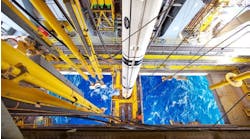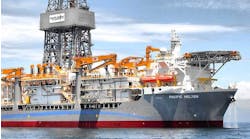Transport a consideration in design selection
A British-Iranian consortium plans to build the Caspian Sea's first deepwater drillship. The vessel is a re-design of the DSV Orelia. It would be built in sections at a yard in Banderabbas on the Persian Gulf coast. The sections would then be transported north by rail to another yard on the southern Caspian coast for assembly and commissioning.
The drillship would be marketed to two groups, NIOC's Caspian drilling arm KEPCO and Shell/Veba/Eni. These are the only two groups that have so far secured exploration rights in the Iranian sector of the Caspian Sea. Their reconnaissance work to date, including new seismic data, has revealed several probable hydrocarbon-bearing structures in water depths of up to 1,000 meters, which would justify the use of a deepwater drilling vessel.
The main partnership driving the drillship project is a consortium of Delta Holdings, providing finance, Iran's Arvandan Shipbuilding and Offshore Construction Support Service Ltd (OCSSL). The latter comprises eight British design/engineering contractors, including Houlder Offshore Engineering. Houlder designed the original Orelia in the early 1980s. Houlder also operated the vessel for several years before selling it to Stena in 1998. The vessel is still in service today, under the management of Technip-Coflexip.
Over the past two years, OCSSL submitted a variety of concepts to the Iranian authorities. The company was able to work with the government through financier Peter Wood, whose dealings with Iran pre-date the 1979 revolution.
Starboard profile of the proposed new drillship. POD reel omitted for clarity.
Arvandan owns both yards proposed for this project. Banderabbas is the lead yard. It has a solid track record for building jackups and other offshore service vessels.
According to Houlder Director Linsley Meadows, the consortium initially considered a deepwater semisubmersible as an alternative to the drillship. A semi could have been shipped south in sections via the Volga River similar to the way pipelay barges and jackups have been transported. However, the shallow waters (4-6 meters) along the west Caspian coast would not accommodate the deep-draft semi, which requires 9 meters water depth for transport
In any case, the consortium felt that the facilities on offer lacked the capability to put together a modern, dynamically positioned (DP) semisubmersible. The DP drillship, if the concept could be kept simple, would be easier to assemble, and could therefore bolster the local labor contribution. It would also cost less to build than a semisubmersible.
Negotiations progressed more slowly than anticipated, although important decisions were due to be made in February. Once the project is approved, assembly at the two yards should take a minimum of two years, followed by a period of commissioning and crew training.
Main drilling items will include:
- 1,250,000 lb hook load derrick
- 3,000 HP drawworks
- 1,000 HP rotary table
- Three 2,000 HP, 5,000 psi mud pumps
- Eight 8,000 lb riser tensioners
- 10,000 psi BOP.
The Class II dynamic positioning system will work in combination with six 2 MW fixed-pitch azimuthing thrusters, six 2 MW diesel prime movers, and four 2 MW generator sets.
Although the hull will follow the basic design for the DSV Orelia, it will be barge-shaped as opposed to ship-shaped, with different displacement requirements. The environmental characteristics of the Caspian, caused by its long, "oblong" shape, will affect the selection of materials and the design of certain equipment items. Although the southern part of the sea is not prone to ice formation in winter, unlike the shallower north, it is prone to strong winds with a high chill factor. This will require the derrick to be strengthened. The vessel is being designed according to normal classification society stipulations.




